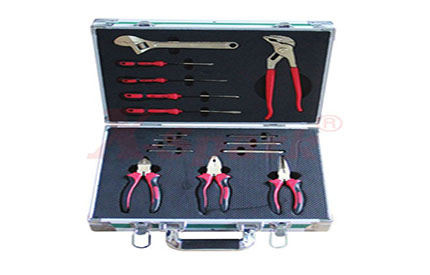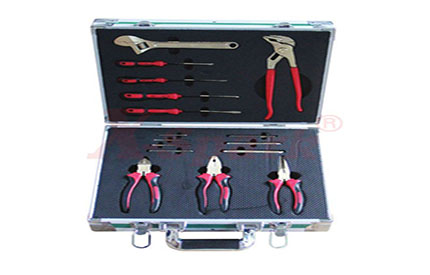Raw material
Explosion proof tools are made of beryllium bronze and aluminum bronze. The beryllium bronze alloy and aluminum bronze alloy do not generate sparks when impacted or rubbed. They are very suitable for manufacturing in explosive, flammable, strong magnetic and corrosive Safety tools used in sexual situations. Bea-20C alloy withstands the impact energy of 561IJ in 30% hydrogen or 6.5-10% methane-air and oxygen. After 20 shocks, no sparks or combustion occurred.
Explosion-proof principle
The material of the explosion-proof tools is copper alloy. Due to the good thermal conductivity of copper and the characteristics of almost no carbon, the friction and impact of tools and objects, the heat generated in a short time is absorbed and conducted. Another reason is that copper itself is relatively It is soft, has good concession during friction and impact, and it is not easy to produce tiny metal particles, so we can hardly see sparks, so explosion-proof tools are also called non-sparking tools.
Scope of application
Petroleum refining and petrochemical industry, coal mine, oil field, natural gas chemical industry, gunpowder industry, chemical fiber industry, paint industry, fertilizer industry, various pharmaceutical industries. Petroleum wheels and liquefied petroleum gas vehicles, airplanes, warehouses that handle flammable and explosive products, electrolysis workshops, communication machine assembly workshops, places where tools are not rusted, wear-resistant, and anti-magnetic, etc.


Explosion Proof Tools
Tool classification
Internationally referred to as "safety tools" and "non-sparking tools", domestically referred to as "explosion-proof tools".
The material is divided into two categories:
1. Aluminum-copper alloy (commonly known as aluminum bronze) explosion-proof tools, the specific material is high-purity electrolytic copper as a matrix, adding appropriate amounts of aluminum, nickel, manganese, iron and other metals to form a copper-based alloy.
2. Beryllium bronze alloy (commonly known as beryllium bronze) explosion-proof tool, the specific material is high-purity electrolytic copper as a matrix, adding an appropriate amount of beryllium, nickel and other metals to form a copper-based alloy.
Both materials have very good thermal and electrical conductivity. After heat treatment, the hardness and wear resistance of aluminum bronze can reach HRC30o or more, which is almost the same as that of beryllium bronze. Beryllium bronze is non-magnetic and can be used in a strong magnetic field environment.
The manufacturing process is divided into two categories:
1. Casting process: It is a traditional manufacturing process, which is an international general manufacturing process technology for explosion-proof tools in the 1980s. Most domestic explosion-proof tool manufacturers have been used to this day.
Advantages: simple process and low manufacturing cost.
Disadvantages: product density, hardness, tensile strength, torque is low, more pores and trachoma result in shorter product life.
2. Forging process: The latest international manufacturing process is made by large-scale presses or punches, combined with high heat-resistant forming molds for one-time forging.
Advantages: It can greatly improve the density, hardness, tensile strength, and torque of the product, basically eliminate porosity and trachoma and make the product's mechanical performance service life about 1 times longer than the traditional casting process.
Disadvantages: large investment in production equipment and molds, resulting in higher costs.
Use and maintenance
Non Sparking Safety Tools should have a proper maintenance phase after our daily work is completed, which is very critical to the life of the tools.
1. After striking 20 times in our daily work, we should deal with the attachments on the surface of the tool, and wipe it before use. Do not use it continuously, so as to avoid the tool being heated due to friction for a long time. damage.
2. After use, wipe the surface of dirt and accumulations and store in a dry and safe place.
3. Percussion tool products should not be hit continuously. There should be appropriate intervals for more than ten times. At the same time, the debris stuck to the product parts should be removed in time before continuing to use it.
4. Wrench products can not be used with excessive force, and can not use sleeves or other metal rods to lengthen the arm and use the hammer to strike (except the wrench) to rotate the fastener.
5. The cutting edge tools should be placed in the water tank to gently touch the grinding wheel for sharpening. Do not use excessive force and contact the grinding wheel for too long.
6. In the actual operation of the hammering tools, the debris on the scene and the oxides corroded on the working surface must be removed to prevent the impact of the third party.
7. Before use, remove the oil on the surface and use it according to the instruction manual.
Tips: In normal use, aluminum-copper alloy is more suitable for atmospheric pressure equipment and environments with less strict explosion-proof requirements (such as gas stations, small oil depots, etc.). Beryllium-copper alloy explosion-proof tools are suitable for applications such as oil refineries and gas transfer. Station, gas production plant, drilling team, and other environments.
评论
发表评论